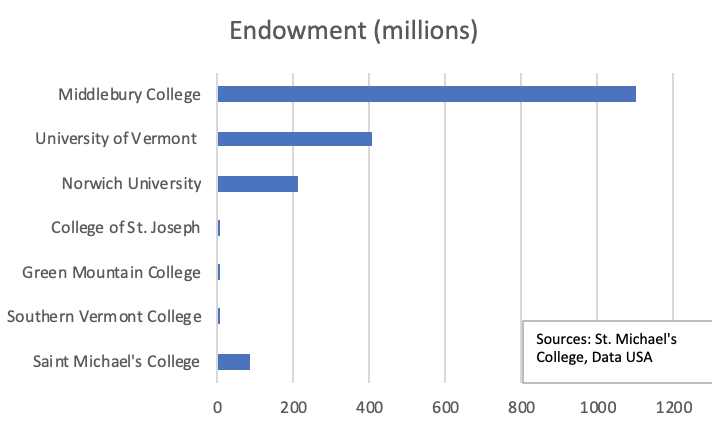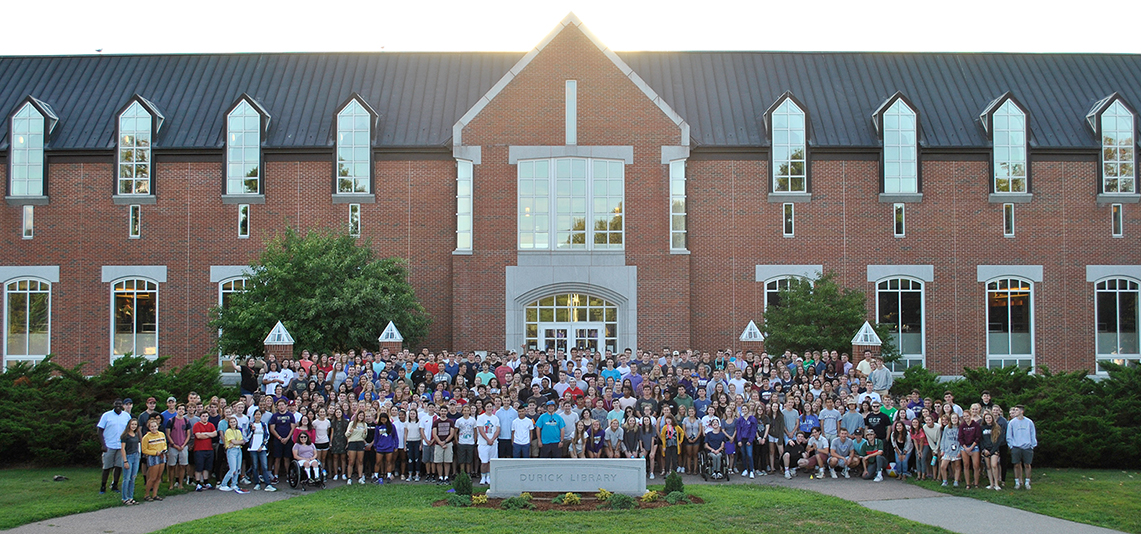
By Matt Heller
Executive Editor
When classes began in late August, Saint Michael’s College, like many higher education institutions across the nation, welcomed an incoming class that fell short of expectations, along with an ongoing budget deficit.
President Lorraine Sterritt declined to comment on the number of students in the class of 2023, explaining that the school wants to avoid having multiple different numbers published. The final number will be released October 15 as part of a census that will be sent to the federal government. Sterritt did say, however, that the school year started with fewer students than she would have liked.
Additionally, Sterritt said the school’s deficit for Fiscal Year 2019 is projected to be around $2 million.
Regional Trends
Declining enrollment has been a trend at St. Michael’s in recent years. In 2014, 2,065 full-time undergraduates were enrolled at the school, highlighted by 610 first-year and transfer students, according to statistics obtained from the college’s Institutional Research. Four years later, in 2018, enrollment had dropped by 396, with only 1,669 undergraduates, including an incoming class of 478 students.
Declining enrollment isn’t just a problem for St. Michael’s. The population of high school students in the Northeast, where Saint Michael’s recruits students, is decreasing. From 2010 to 2017, the number of high school students in the Northeast declined by about 200,000, according to the United States Census Bureau. And the numbers will keep going down.
The Western Interstate Commission on Higher Education predicts a decrease from 610,000 Northeast high school graduates in 2017 to 562,500 in 2031. This leads to increased competition between schools to recruit from the limited pool of students. The number of high school graduates in the foreseeable future will continue to decrease, a factor colleges are watching closely.
“The days are gone when you can lay back and have students come to your door,” Sterritt said. For St. Michael’s, this reality has evoked a need for more advertising and recruitment. Sterritt mentioned that the school is advertising on public radio, television, billboards, the Boston transit system, and the school’s newly rented coach bus, sporting a bright purple knight logo.
Sterritt has also promoted new academic programs and a new Center for the Environment as investments intended to attract prospective students.
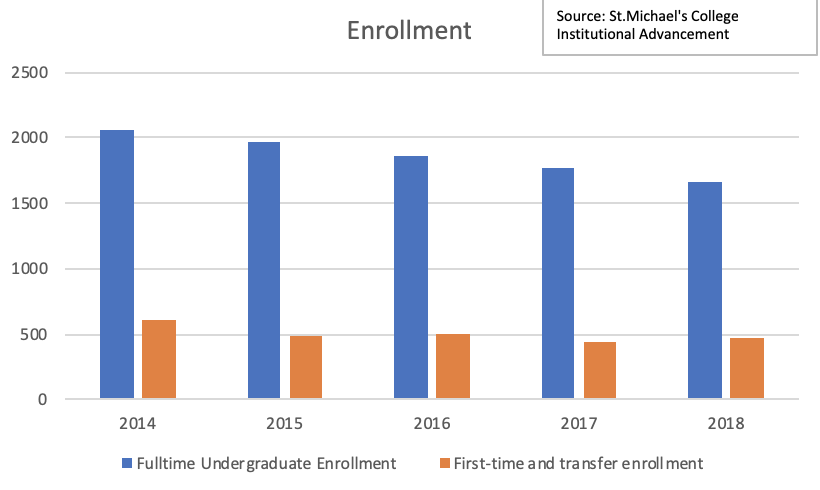
Recruitment Strategies
With most of our students coming from the Northeast, the school is looking to expand recruitment both domestically and internationally. According to this academic year’s Admission & Enrollment Profile, 74 percent of St. Michael’s students come from New England, including 31 percent from Massachusetts and 15 percent from Vermont. However, from 2017 to 2018, Vermont saw more than a 10 percent population decrease in people under the age of 18, ranking the state last in the nation. Massachusetts decreased by more than three percent, according to an analysis of census population estimates.
“We are certainly looking towards places that the population is not having a dramatic decrease as it is in New England,” said Michael Stefanowicz, director of admission. This pipeline development method is one of the ways the school hopes to target the right prospective students. The school has also employed a search program that helps target students with SAT, ACT, and survey question responses that match our general student profile.
Some staff was laid off this summer and positions vacated by retirements have remained unfilled. However, the Admission Office has added two regional representatives, according to Stefanowicz. One is based in Worcester, Mass. to sustain reach in the primary market, while another is based in Annapolis, Md. in an attempt to build a secondary market. Additionally, the school has two international admission staff, including Kevin Spensley, who has recently spent time recruiting in Japan.
St. Michael’s currently has representation from 37 countries, according to the Admission & Enrollment profile.
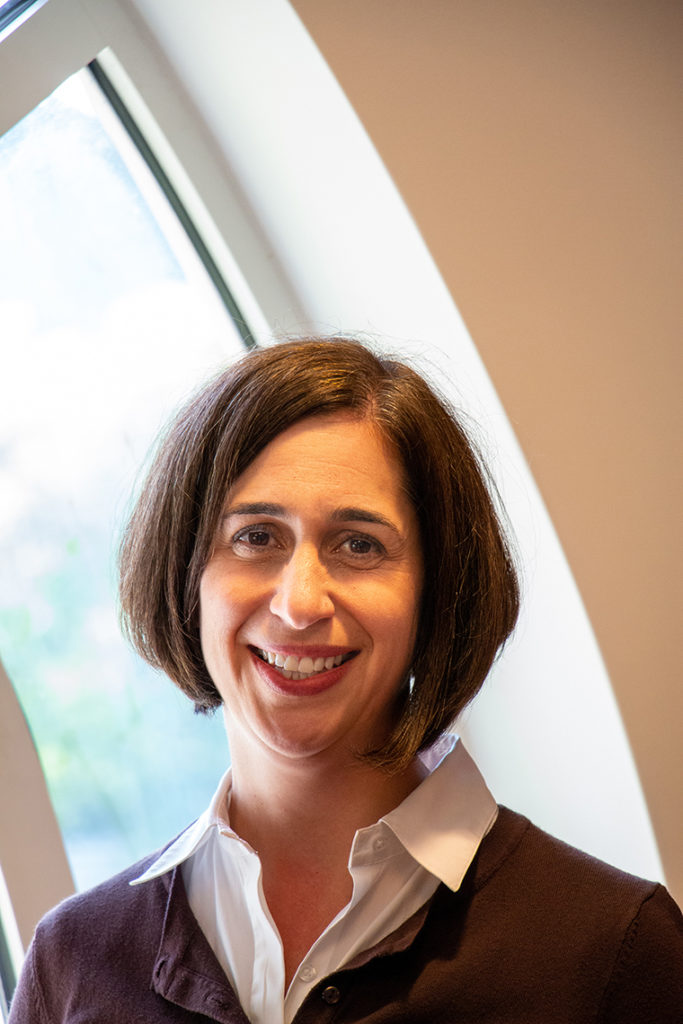
“We can’t be this place that’s just up in Northern Vermont. We have to be a place that is global in perspective,” said Kristin McAndrew, the new vice president for enrollment and marketing.
McAndrew, whose first meeting on-campus upon the start of her position was with President Sterritt, was told to write a “new and robust” international recruitment plan. McAndrew was most recently the director of admission at the University of Notre Dame’s Mendoza College of Business. She has dealt with similar declining enrollment as director of admission at Saint Mary’s College, as well as nationally-declining enrollment for MBA programs during her time at Notre Dame.
“What made me choose to come to St. Michael’s is the fact that every member of this community that I’ve interviewed with is committed to being a part of the solution… it’s a campus problem that the whole community is going to tackle together,” said McAndrew.
One of McAndrew’s new relationships will be with Institutional Advancement to garner alumni support. She said the work of the two offices are “inextricably linked,” as a better connection with alumni can bring in more money and help spread the word to prospective students.
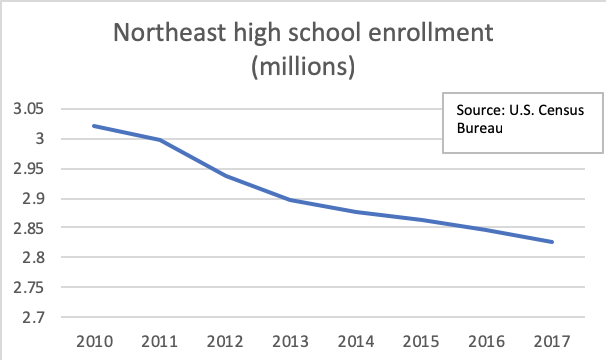
Why choose college?
In the eyes of a prospective student, tuition is a major factor. According to the College Board, the average tuition and fees for a private, non-profit, four-year college rose to $35,830 in 2018-19. According to the St. Michael’s website, tuition for the 2019-2020 school year is $45,050. However, with most students receiving financial aid, the 2017-2018 average net price for full-time beginning undergraduates was $31,323, according to the National Center for Education Statistics. In that same year, 1,754 undergraduates received grants or scholarship aid, totaling over $42 million, averaged at $24,153 per student.
The popularity of alternative, often cheaper options such as trade schools, has grown as a result of escalating college costs. The U.S. Department of Education reported a rise from about 9.6 million trade school students in 1999 to about 16 million in 2014.
Given these trends, institutions must prove to students why they should invest in a college degree.
“I’m confident college continues to be the very best investment somebody can make in their future. We need to really be able to show and tell what you get for investing in yourself and attending a place like St. Michael’s,” Stefanowicz said.
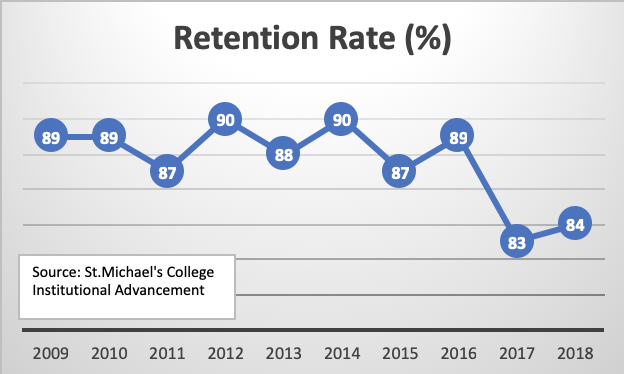
Institutions must also be able to retain the students they enroll. In 2018, St. Michael’s had an 84 percent retention rate, according to Institutional Research. This means that 84 percent of incoming students enrolled in the fall of 2017 returned in the fall of 2018. By comparison, Middlebury College had a retention rate of 96 percent, and the University of Vermont had a retention rate of 87 percent, according to the National Center for Education Statistics.
In the past year, Southern Vermont College, Green Mountain College, and the College of St. Joseph all struggled to meet financial demands with their accreditor, the New England Commission on Higher Education, and ultimately closed their doors. According to Inside Higher Ed, Southern Vermont had a deficit of around $2 million, approximately the same as St. Michael’s. The school had to lower enrollment numbers and made the decision to shut down.
“I think it’s unfair to compare ourselves to [Green Mountain College] or to [Southern Vermont College] because they really are in a completely different experience,” said Stefanowicz, noting endowment, the composition of the student body, and a more rural location as factors that set these schools apart from St. Michael’s. According to the St. Michael’s College website, our endowment is approximately $85 million, compared to endowments of less than $4 million for each of the three schools that closed. Despite this advantage for St. Michael’s, other Vermont institutions, including Norwich University ($209 million), the University of Vermont ($405 million) and Middlebury College ($1.1 billion) have much larger endowments.
Sterritt referenced the new branding language regarding doing well and doing good when she talked about the school’s future, noting that many colleges are facing financial challenges and must innovate.
“For Saint Michael’s College,” she said, “ that is preparing students to do well in their chosen fields and inspiring them to do good in the world. There will always be a market for that.”
